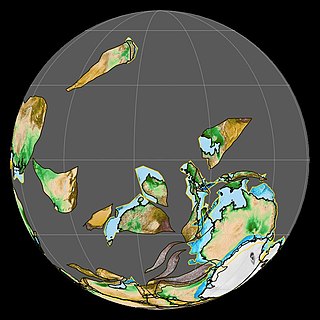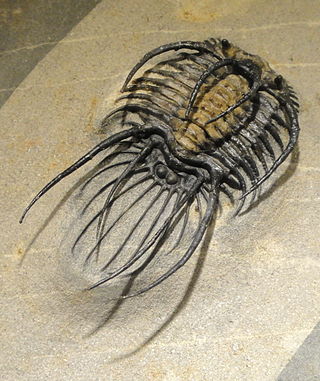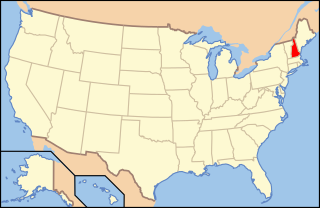
The Devonian is a geologic period and system of the Paleozoic era during the Phanerozoic eon, spanning 60.3 million years from the end of the preceding Silurian period at 419.62 million years ago (Ma), to the beginning of the succeeding Carboniferous period at 358.86 Ma. It is the fourth period of both the Paleozoic and the Phanerozoic. It is named after Devon, South West England, where rocks from this period were first studied.

Trilobites are extinct marine arthropods that form the class Trilobita. Trilobites form one of the earliest known groups of arthropods. The first appearance of trilobites in the fossil record defines the base of the Atdabanian stage of the Early Cambrian period and they flourished throughout the lower Paleozoic before slipping into a long decline, when, during the Devonian, all trilobite orders except the Proetida died out. The last trilobites disappeared in the mass extinction at the end of the Permian about 251.9 million years ago. Trilobites were among the most successful of all early animals, existing in oceans for almost 270 million years, with over 22,000 species having been described.

Eldredgeops rana is a species of trilobite from the middle Devonian period. Their fossils are found chiefly in the northeastern United States, and southwestern Ontario.

The Tournaisian is in the ICS geologic timescale the lowest stage or oldest age of the Mississippian, the oldest subsystem of the Carboniferous. The Tournaisian age lasted from 358.86 Ma to 346.7 Ma. It is preceded by the Famennian and is followed by the Viséan. In global stratigraphy, the Tournaisian contains two substages: the Hastarian and Ivorian. These two substages were originally designated as European regional stages.

Greenops is a mid-sized Devonian trilobite of the order Phacopida, subfamily Asteropyginae. They are mainly reported from the mid-Devonian Hamilton Group of upstate New York and southwestern Ontario. A similar-looking trilobite from Morocco is often mis-labelled Greenops. Greenops had schizocroidal eyes, large genal spines and short, sharp spines at the tip of each segment of the pygidium ("tail"). Greenops lived in warm, fairly deep water. In the Hamilton Group of New York, they are found with Eldredgeops, Dipleura and Bellacartwrightia, a trilobite that resembles Greenops but has much larger pygidial spines. In Ontario, they are found in the Widder Formation, which outcrops at Arkona, where they are, by far, the dominant trilobite.

Paralejurus is a genus of trilobite from the Late Silurian to the Middle Devonian of Africa and Europe.

Rusophycus is an ichnogenus of trace fossil allied to Cruziana. Rusophycus is the resting trace, recording the outline of the tracemaker; Cruziana is made when the organism moved. The sculpture of Rusophycus may reveal the approximate number of legs that the tracemaker had, although striations (scratchmarks) from a single leg may overlap or be repeated.

Cyphaspis is a genus of small trilobite that lived from the Late Ordovician to the Late Devonian. Fossils have been found in marine strata in what is now Europe, Africa and North America. Various species had a compact body, and a large, bulbous glabellum. Many species had long spines arranged similarly to closely related genera, such as Otarian, Otarionella, Chamaeleoaspis, and Namuropyge.

Odontopleurida is an order of very spinose trilobites closely related to the trilobites of the order Lichida. Some experts group the Odontopleurid families, Odontopleuridae and Damesellidae, within Lichida. Odontopleurids tend to have convex, bar-shaped cephalons, and lobed, knob-shaped glabella that extend to, or almost to the anterior margin. Many, if not almost all odontopleurids have long spines that are derived either from the margins of the exoskeleton, or from granular or tubercular ornamentation, or both. Many odontopleurids are so spinose so as to be described as having "spines on (their) spines." Odontopleurids have 8 to 13 thoracic segments, with Odontopleuridae odontopleurids having no more than 10, and Damesellidae odontopleurids having no more than 13. The pygidium tends to be very small, and invariably has long spines emanating from it in all known genera.

Odontopleuridae is a family of odontopleurid trilobites found in marine strata throughout the world. Odontopleurids of Odontopleuridae first appear in Late Cambrian-aged marine strata, and the last genera perish by the end of the Frasnian stage during the Late Devonian. The members of Odontopleuridae are famous for their spinose appearance, having long, often numerous spines along the edges of their exoskeletons, and derived from ends of segments or tubercle ornaments.

The Devonian Jeffersonville Limestone is a mapped bedrock unit in Indiana and Kentucky. It is highly fossiliferous. The Vernon Fork Member contains Volcanic ash associated with the Tioga Bentonites.

Paleontology in Ohio refers to paleontological research occurring within or conducted by people from the U.S. state of Ohio. Ohio is well known for having a great quantity and diversity of fossils preserved in its rocks. The state's fossil record begins early in the Paleozoic era, during the Cambrian period. Ohio was generally covered by seawater from that time on through the rest of the early Paleozoic. Local invertebrates included brachiopods, cephalopods, coral, graptolites, and trilobites. Vertebrates included bony fishes and sharks. The first land plants in the state grew during the Devonian. During the Carboniferous, Ohio became a more terrestrial environment with an increased diversity of plants that formed expansive swampy deltas. Amphibians and reptiles began to inhabit the state at this time, and remained present into the ensuing Permian. A gap in the local rock record spans from this point until the start of the Pleistocene. During the Ice Age, Ohio was home to giant beavers, humans, mammoths, and mastodons. Paleo-Indians collected fossils that were later incorporated into their mounds. Ohio has been the birthplace of many world famous paleontologists, like Charles Schuchert. Many significant fossils curated by museums in Europe and the United States were found in Ohio. Major local fossil discoveries include the 1965 discovery of more than 50,000 Devonian fish fossils in Cuyahoga County. The Ordovician trilobite Isotelus maximus is the Ohio state invertebrate fossil.

Paleontology in Pennsylvania refers to paleontological research occurring within or conducted by people from the U.S. state of Pennsylvania. The geologic column of Pennsylvania spans from the Precambrian to Quaternary. During the early part of the Paleozoic, Pennsylvania was submerged by a warm, shallow sea. This sea would come to be inhabited by creatures like brachiopods, bryozoans, crinoids, graptolites, and trilobites. The armored fish Palaeaspis appeared during the Silurian. By the Devonian the state was home to other kinds of fishes. On land, some of the world's oldest tetrapods left behind footprints that would later fossilize. Some of Pennsylvania's most important fossil finds were made in the state's Devonian rocks. Carboniferous Pennsylvania was a swampy environment covered by a wide variety of plants. The latter half of the period was called the Pennsylvanian in honor of the state's rich contemporary rock record. By the end of the Paleozoic the state was no longer so swampy. During the Mesozoic the state was home to dinosaurs and other kinds of reptiles, who left behind fossil footprints. Little is known about the early to mid Cenozoic of Pennsylvania, but during the Ice Age it seemed to have a tundra-like environment. Local Delaware people used to smoke mixtures of fossil bones and tobacco for good luck and to have wishes granted. By the late 1800s Pennsylvania was the site of formal scientific investigation of fossils. Around this time Hadrosaurus foulkii of neighboring New Jersey became the first mounted dinosaur skeleton exhibit at the Academy of Natural Sciences in Philadelphia. The Devonian trilobite Phacops rana is the Pennsylvania state fossil.

Paleontology in Vermont comprises paleontological research occurring within or conducted by people from the U.S. state of Vermont. Fossils are generally uncommon in Vermont. Nevertheless, however, significant finds have been made in the state. Very few fossils are known in Vermont east of the Green Mountains due to the type of rock underlying that area. During the early part of the Paleozoic era, Vermont was covered by a warm, shallow sea that would end up being home to creatures like brachiopods, corals, crinoids, ostracoderms, and trilobites. There are no rocks in the state from the Carboniferous, Permian, Triassic, or Jurassic periods. The few Cretaceous rocks present contain no fossils. The Paleogene and Neogene periods are also absent from the local rock record. During the Ice Age, glaciers scoured the state. At times the state was inundated by seawater, allowing marine mammals to venture in. After the seawater drained away the state was home to mastodons. Local fossils had already attracted scientific attention by the mid-19th century when mastodon remains were found in Rutland County. In 1950 a major Paleozoic invertebrate find occurred. The Pleistocene Beluga whale Delphinapterus leucas is the Vermont state fossil.

Paleontology in New Hampshire refers to paleontological research occurring within or conducted by people from the U.S. state of New Hampshire. Fossils are very rare in New Hampshire because so much of the state's geology is highly metamorphic. The state's complicated geologic history has made dating its rocks and the fossils they contain "a difficult task." The state's Devonian rocks are especially metamorphosed, yet its Mississippian rocks formed too recently to have been subject to the same metamorphism. Nevertheless, despite the geologic complications some fossils have been discovered in the state.

Paleontology in Wisconsin refers to paleontological research occurring within or conducted by people from the U.S. state of Wisconsin. The state has fossils from the Precambrian, much of the Paleozoic, some parts of the Mesozoic and the later part of the Cenozoic. Most of the Paleozoic rocks are marine in origin. Because of the thick blanket of Pleistocene glacial sediment that covers the rock strata in most of the state, Wisconsin’s fossil record is relatively sparse. In spite of this, certain Wisconsin paleontological occurrences provide exceptional insights concerning the history and diversity of life on Earth.

Paleontology in Texas refers to paleontological research occurring within or conducted by people from the U.S. state of Texas. Author Marian Murray has said that "Texas is as big for fossils as it is for everything else." Some of the most important fossil finds in United States history have come from Texas. Fossils can be found throughout most of the state. The fossil record of Texas spans almost the entire geologic column from Precambrian to Pleistocene. Shark teeth are probably the state's most common fossil. During the early Paleozoic era Texas was covered by a sea that would later be home to creatures like brachiopods, cephalopods, graptolites, and trilobites. Little is known about the state's Devonian and early Carboniferous life. Evidence indicates that during the late Carboniferous the state was home to marine life, land plants and early reptiles. During the Permian, the seas largely shrank away, but nevertheless coral reefs formed in the state. The rest of Texas was a coastal plain inhabited by early relatives of mammals like Dimetrodon and Edaphosaurus. During the Triassic, a great river system formed in the state that was inhabited by crocodile-like phytosaurs. Little is known about Jurassic Texas, but there are fossil aquatic invertebrates of this age like ammonites in the state. During the Early Cretaceous local large sauropods and theropods left a great abundance of footprints. Later in the Cretaceous, the state was covered by the Western Interior Seaway and home to creatures like mosasaurs, plesiosaurs, and few icthyosaurs. Early Cenozoic Texas still contained areas covered in seawater where invertebrates and sharks lived. On land the state would come to be home to creatures like glyptodonts, mammoths, mastodons, saber-toothed cats, giant ground sloths, titanotheres, uintatheres, and dire wolves. Archaeological evidence suggests that local Native Americans knew about local fossils. Formally trained scientists were already investigating the state's fossils by the late 1800s. In 1938, a major dinosaur footprint find occurred near Glen Rose. Pleurocoelus was the Texas state dinosaur from 1997 to 2009, when it was replaced by Sauroposeidon after the Texan fossils once referred to the former species were reclassified to a new genus.

The Milwaukee Formation is a fossil-bearing geological formation of Middle Devonian age in Milwaukee County, Wisconsin. It stands out for the exceptional diversity of its fossil biota. Included are many kinds of marine protists, invertebrates, and fishes, as well as early trees and giant fungi.
The Arauz Formation is an Emsian fossiliferous stratigraphic unit in Spain. It is a member of the Abadia Group. It is situated in the Province of Palencia, North Spain. It is in the north of Natural Park of Fuentes Carrionas and Fuente Cobre-Montaña Palentina where the Rio Arauz lies. It is from the Devonian of Spain.
2021 in arthropod paleontology is a list of new arthropod fossil taxa, including arachnids, crustaceans, insects, trilobites, and other arthropods that were announced or described, as well as other significant arthropod paleontological discoveries and events which occurred in 2021.

















